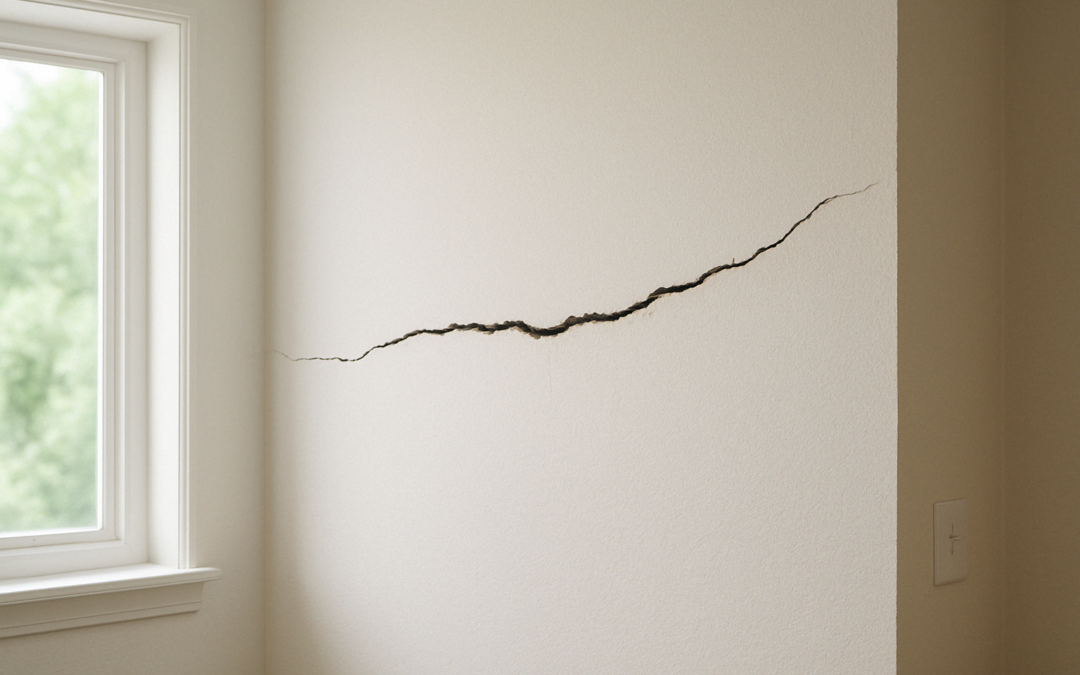Cracks in walls and ceilings are common in homes, often resulting from natural settling or environmental changes. Minor cracks may appear harmless, but should still be monitored over time. While most small cracks are cosmetic, they sometimes hint at underlying structural movement.
However, cracks exceeding 1/8 inch in width may indicate significant structural movement beneath the surface. These wider cracks are major red flags and deserve immediate attention from homeowners and professionals alike. Left unaddressed, they can lead to severe damage, compromise safety, and result in expensive repairs. Early detection and expert evaluation can help prevent further issues and protect your home’s long-term stability and value.
Understanding the Significance of Crack Width
Cracks less than 1/8 inch wide are typically considered cosmetic. They often result from minor settling, temperature fluctuations, or seasonal humidity. These hairline cracks usually pose no structural risk and can be fixed with patching and paint.
In contrast, cracks wider than 1/8 inch may signify deeper structural problems. According to the International Association of Certified Home Inspectors, cracks over 1/8 inch in width often suggest structural movement and may require professional evaluation. These larger cracks can develop from foundation settling, soil expansion, or shifting load-bearing components.
Identifying Serious Structural Cracks
Certain crack patterns and characteristics can help you determine whether you’re dealing with a serious issue:
- Direction and Pattern: Diagonal, vertical, or stair-step cracks wider than 1/8 inch often signal foundation movement or stress.
- Location: Cracks forming near doorways, windows, or ceiling corners may suggest shifting in the home’s frame.
- Recurrence: Cracks that return after repair or continue to widen are signs of an ongoing structural issue.
- Depth and Texture: Deep cracks that penetrate the drywall or plaster surface could mean more than surface damage.
If you notice a combination of these signs, especially with cracks above the 1/8-inch threshold, it’s time to take action.
When to Consult a Structural Engineer
You should consult a structural engineer if a crack exceeds 1/8 inch in width or continues to grow. These professionals assess the underlying causes and determine the severity of the movement. A visual inspection by a contractor isn’t enough for structural concerns, especially if the damage appears near doors, windows, or load-bearing walls.
Structural engineers can also determine whether the movement has stabilized or is active. Some cracks may stop growing once the home settles, but others may worsen. Sometimes, they’ll use monitoring tools to track changes over time, providing a more accurate diagnosis.
An engineer’s report may recommend repairs ranging from simple reinforcement to extensive foundation work. The key is identifying the problem before it spreads and becomes more complex or costly.
Why These Cracks Can’t Wait
Cracks from structural movement rarely resolve on their own. Many worsen with time, moisture, or temperature shifts. Left untreated, structural cracks can lead to wall separation, ceiling sagging, or even compromised load-bearing elements. These issues can affect your home’s safety, resale value, and insurability. 
More than 60% of homes built on expansive soils experience some form of foundation movement during their lifetime. In areas like Florida, with sandy soil and heavy rainfall, foundation shifting is common. Coastal weather patterns, storm surges, and seasonal humidity contribute to soil instability. If ignored, a crack that starts as a cosmetic concern can escalate into a major repair that affects multiple areas of your home.
Waiting may also cost you more. A minor structural repair might cost a few hundred dollars. However, extensive foundation damage can easily exceed $10,000. Delaying an evaluation could also result in additional costs from water damage, mold remediation, or compromised insulation.
Preventative Measures and Maintenance
You can’t always prevent cracks, but you can reduce the risks by taking proactive steps:
- Maintain Proper Drainage: Ensure gutters and landscaping direct water away from your foundation.
- Monitor Humidity Levels: Use dehumidifiers in humid climates to reduce expansion in framing materials.
- Control Tree Roots: Keep large trees away from your home’s foundation to avoid root-related soil displacement.
- Inspect Regularly: Walk around your home each season. Look for new cracks or changes to existing ones.
Homeowners who stay proactive can catch minor issues before they become significant problems.
What to Do If You See a Crack Over 1/8 Inch
If you notice a large crack, don’t panic—but don’t ignore it either. Start by taking measurements and photographs. Mark the ends of the crack with a pencil and date them. Monitor it weekly for width, length, or shape changes, noting any new developments or spreading.
If the crack grows or matches any warning signs discussed, it’s time to act. Contact a drywall professional first—they can evaluate the damage, perform minor repairs if appropriate, and advise whether a structural engineer should be brought in. A qualified drywall expert can often spot signs of more serious issues early. They can refer you to a licensed engineer for a full inspection. Some companies even offer affordable home evaluations and maintain trusted repair contractor networks.
Don’t Delay Structural Repairs
A drywall crack wider than 1/8 inch can be the tip of the iceberg. Structural issues hidden behind the surface may already be developing. These problems often start small and quietly, without other obvious signs. If caught early, they’re often easy to manage and affordable to fix before compromising safety or leading to more extensive repairs.
Whether you’re a new homeowner or have lived in your house for years, staying alert to these signs is essential. Regular inspections, timely evaluations, and professional advice can protect your investment and ensure your home remains safe and structurally sound for years.
For Tampa-area homeowners, where shifting soil, humidity, and rainfall can amplify issues, paying attention to wall and ceiling cracks isn’t just a good idea—it’s essential for long-term peace of mind.



You must be logged in to post a comment.